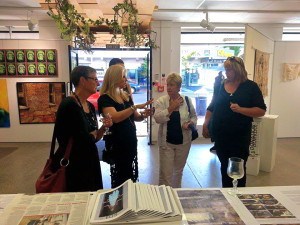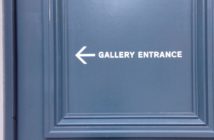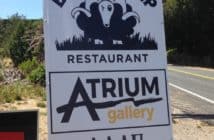 Tauranga is home to significant fabric creative Debra Laraman. An exhibition of Laraman’s ecologically and sustainability referenced fashion garments is currently showing at the Creative Tauranga Community Gallery, Willow Street, Tauranga as “RD4 An Alternative Approach”. On until 30th March 2015 it’s not to be missed by anyone in the community.
Tauranga is home to significant fabric creative Debra Laraman. An exhibition of Laraman’s ecologically and sustainability referenced fashion garments is currently showing at the Creative Tauranga Community Gallery, Willow Street, Tauranga as “RD4 An Alternative Approach”. On until 30th March 2015 it’s not to be missed by anyone in the community.
I’m heading up to Tauranga on an indifferent Bay of Plenty early autumn late afternoon. The skies are multi-leveled and multi-coloured, clumps of dirty white and assorted greys. The windscreen wipers thwack to clear the moderate persistent rain. I’m driving down the Whakamarama Hill much slower than usual but even so the car suddenly slides towards the centre line as I hit one of those summer-reminiscent patches of oil slick. The car stays on my side of the road and avoids the on-coming European created tank – we all know who would have come off worse in that encounter and it wasn’t the Mercedes.
It’s still raining when I arrive in Downtown Tauranga, about 17 minutes drive from home. I go straight to the Tauranga City Library carpark and park as close to the entrance to that complex as legally possible. Then, best-parka garbed I scuttle through the outdoor corridors onto Willow Street, past the Tauranga Library and into the warm and welcoming glow of Creative Tauranga on the opposite corner.
The front foyer of Creative Tauranga is already alive – there’s a publisher’s table set up next to a table with scrumptious nibbles (including a platter of Louise Cake – I’m almost delirious I adore that combination of meringue, jam and shortcake). Glasses of wine are set out on the top of the reception counter under the command of Gallery curator Millie Newitt. Through the glass screen Maria Johnson is visible, still working away at the computer. People are talking and taking subscriptions to Freelance. That’s what this event is all about – the relaunch of the subscription based “writers helping writers” magazine – Freelance under the editorship of Jenny Argante and her talented team. That’s why I’m here but I’m immediately drawn to the adjacent gallery area displaying an array of very different garments. It’s the law of unintended consequences!!
Deborah Laraman is obviously a woman of talent. There is a collection of clothing and homewares worthy of any sophisticated metropolitan area.
Dominating the exhibition are the merino, (and silk) creations dyed with New Zealand native plants creating unique, tie-dyed, camo-patterned garments. Many reference traditional Asian garments. “What’s that?” says a man standing next to me, pointing to a Korean styled cardigan-jacket. I explain what I think it is and sure enough later when I’m reading the superb Look Book created by Laraman and her daughter Jade there is an image of it being worn exactly as I envisaged from the wall display.
There are draped dresses which could be worn anywhere. A series of scarves with long and obvious top-stitching show off a diversity of naturally created colours and patterns. Autumn-toned, top-stitched cushions rest on lightly coloured merino shawl-throws. There are two shoulder-shrugs in off-white wool, both with large and loosely patterned stitches. One is crocheted, the other is knitted. I can’t work out whether the details are plaited or knitted. It’s only now I realise these two garments complement and accompany the naturally dyed dresses I’ve been describing. These garments and homewares are a discrete collection within the larger exhibition.
Just as interesting and exciting are the garments Laraman has created “re-using” other clothing, predominantly tee shirts. “I bet she’s used indigo” says another Freelance launch attender who’s drifted into the Gallery space. We’re looking at two inky-blue draped dresses. I lift the folds and show her that they are recycled tee shirts. There are other tee shirt dresses made with toning layers. They are all amazing and more importantly, they are all absolutely wearable as fashion garments. There is a series of accompanying shrugs in toning blues, maroons and one featuring a repurposed, indigo-dyed crocheted doily. ARTbop’s own fabric creative star Diane Hume-Green (here tonight as a writer and associate of Freelance Editor Argante) tells me these shrugs are made of torn strips of tee shirt jersey. When torn the strips roll in on themselves creating a modern version of the folded cotton used in traditional Battenberg lace.
Part of this collection includes several wear-worthy black garments: they are so well done they look cosmopolitan catwalk. They are accompanied by a string of modern Battenberg neck, or rather, decolletage adornments.
There are one or two outstanding random dresses: I can’t neatly consign them to either of the categories above. One appears to be multi-layered black merino top-stitched with those long khaki/donkey brown/taupe threads. The other a beautifully draped black merino dress with an overall rust pattern- evening or business, it could be either.
 Entirely random in style and design but part of the overall concept of repurposing and recycling was the “star of the show”. Like a woman in a white dress when everyone else has come in black. It’s a capelet created by Laraman from a suit jacket. It’s embellished with embroidery and traditional applique giving the garment a totally out there look while being obviously wearable. Tracey Rudduck-Gudsell tells me she has bought this work of art. Tracey (who is here hosting the Freelance launch) tells me about the responses and reactions of other purchasers (including other Creative Tauranga staff members). Tracey also refers me to the promotional article in March creativebeat magazine and brings out the design range Look Book.
Entirely random in style and design but part of the overall concept of repurposing and recycling was the “star of the show”. Like a woman in a white dress when everyone else has come in black. It’s a capelet created by Laraman from a suit jacket. It’s embellished with embroidery and traditional applique giving the garment a totally out there look while being obviously wearable. Tracey Rudduck-Gudsell tells me she has bought this work of art. Tracey (who is here hosting the Freelance launch) tells me about the responses and reactions of other purchasers (including other Creative Tauranga staff members). Tracey also refers me to the promotional article in March creativebeat magazine and brings out the design range Look Book.
The capelet is like many of these fashion-art garments on display. Laraman has created items which transcend style. Items that would form part of a “wardrobe” for a lifetime. Clothing that you would not only wear repeatedly but would occasionally take out merely to hold and enjoy for its originality and creativity.
I’ve mentioned the Look Book created by Laraman with photography by her daughter Jade Laraman. This is a work of art on its own account as is the bunting created to support the exhibition. There’s also the naturally dyed appliqued and top-stitched exhibition sign. This is another Laraman work and displays all the elements of repurposing and creativity apparent in the exhibition. Laraman’s fundamental ecological ethos is clearly stated in the Look Book
“it takes 2,700 litres of water to make one shirt – enough for 1 person to drink
for 900 days. Cotton uses 22.5% of the world’s insecticides; 10% of all pesticides and 2.5% of the earth’s agricultural land”
I’ve said this is unmissable. While I was there last night teenagers viewed the exhibition with intensity. Mature gentlemen walked around with interest. The women attending stared, touched and appreciated. It’s unmissable for its use of natural dyes and natural fibres. It’s unmissable for its recycling and repurposing ethic. It’s unmissable because the work is beautiful. If you’re in Tauranga before 30th March 2015 make an effort to view Laraman’s work. The Creative Tauranga Community Gallery, Corner Willow and Wharf Streets, Downtown Tauranga is open from 9am to 5pm weekdays
Rosemary Balu
Notes:
1. Laraman’s clothing and design label is Lara Mann. Debra Laraman can be contacted by email at laraman@ihug.co.nz or by cell on 027 365 4077. “..Laraman is a multi-award winning designer. After 14 years leading the Fashion and Design programmes at Bay of Plenty Polytechnic Deb became Head of Creative Art and Design at Waiariki Institute of Technology” Creativebeat, March 2015, Page 11
2. This exhibition of repurposed fabric and garments is coincidental with he 2015 Sustainable Backyards calendar organised by Envirohub, Bay of Plenty Look at www.envirohub.org.nz and sby@envirohub.org.nz for the on-going programme of events including the Laraman organised Too Good to Toss – recycled clothing, accessories etc sale at the Historic Village 29th March 2015







